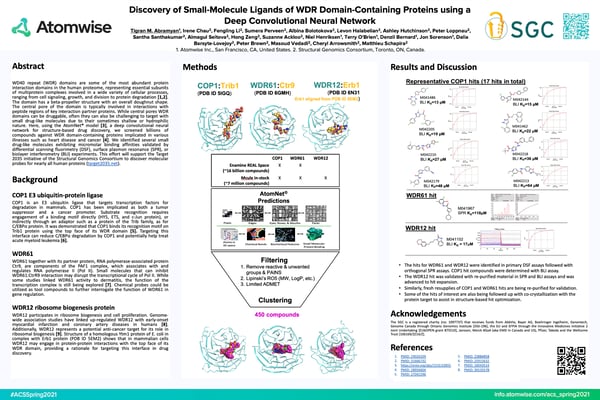Discovery of Inhibitors of WDR Domain-Containing Proteins using a Deep Convolutional Neural Network
At the American Chemical Society Spring 2021 Virtual Meeting & Expo, several Atomwise members and partners were selected to present their research and work. Learn what our Atoms have been working on below and visit Atomwise at ACS Spring 2021 Virtual Meeting & Expo for other presentation sessions.
 Tigran Abramyan, PhD
Tigran Abramyan, PhD
Atomwise
Title: Discovery of Inhibitors of WDR Domain-Containing Proteins using a Deep Convolutional Neural Network
Division: MEDI
Authors: Tigran M. Abramyan (1), Irene Chau (2), Fengling Li (2), Sumera Perveen (2),
Albina Bolotokova (2), Levon Halabelian (2), Ashley Hutchinson (2), Peter Loppnau (2), Santha Santhakumar (2), Almagul Seitova (2), Hong Zeng (2), Suzanne Ackloo (2), Niel Henriksen (1), Terry O'Brien (1), Denzil Bernard (1), Jon Sorenson (1), Dalia Barsyte-Lovejoy (2), Peter Brown (2), Masoud Vedadi (2), Cheryl Arrowsmith (2), Matthieu Schapira (2)
Institutions:
1. Atomwise Inc, San Francisco, CA, United States.
2. Structural Genomics Consortium, Toronto, ON, Canada.
Abstract
WD40 repeats (or WDR domains) are some of the most abundant protein interaction domains in the human proteome, representing essential subunits of multiprotein complexes involved in a wide variety of cellular processes, ranging from cell signaling, growth, and division to protein degradation. The domain has a beta-propeller structure with an overall doughnut shape. The central pore of the domain is typically involved in interactions with peptide regions of key interaction partner proteins. While these pores of some WDR domains could be druggable pockets, often they can be challenging to target with small drug-like molecules due to their relatively shallow and solvent exposed nature. Here, using the AtomNet® model, a deep convolutional neural network for structure-based drug discovery, we screened billions of compounds against WDR domain-containing proteins, implicated in various illnesses such as heart disease and cancer. We identified several small drug-like molecules exhibiting micromolar binding affinities validated by differential scanning fluorimetry and surface plasmon resonance experiments. This effort will support SGC’s Target 2035 initiative to discover molecular probes for nearly all human proteins.
Poster Presentation
View Poster
Listen to the Poster Presentation audio recording
Join our team
Our team is comprised of over 80 PhD scientists who contribute to a high-performance academic-like culture that fosters robust scientific and technical excellence. We strongly believe that data wins over opinions, and aim for as little dogma as possible in our decision making. Learn more about our team and opportunities at Atomwise.
Related Posts
Subscribe
Stay up to date on new blog posts.
Atomwise needs the contact information you provide to send you updates. You may unsubscribe from these communications at any time. For information please review our Privacy Policy.

